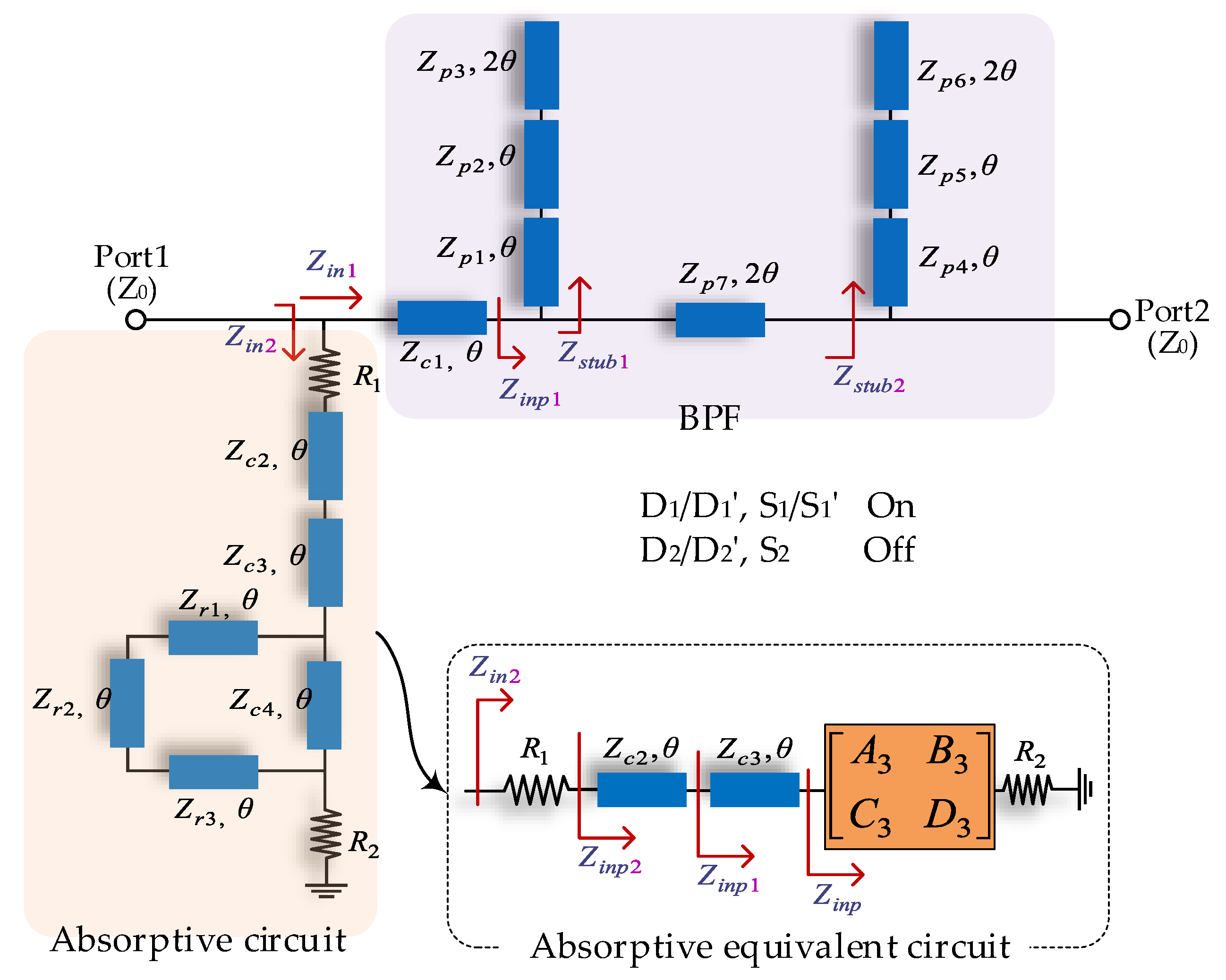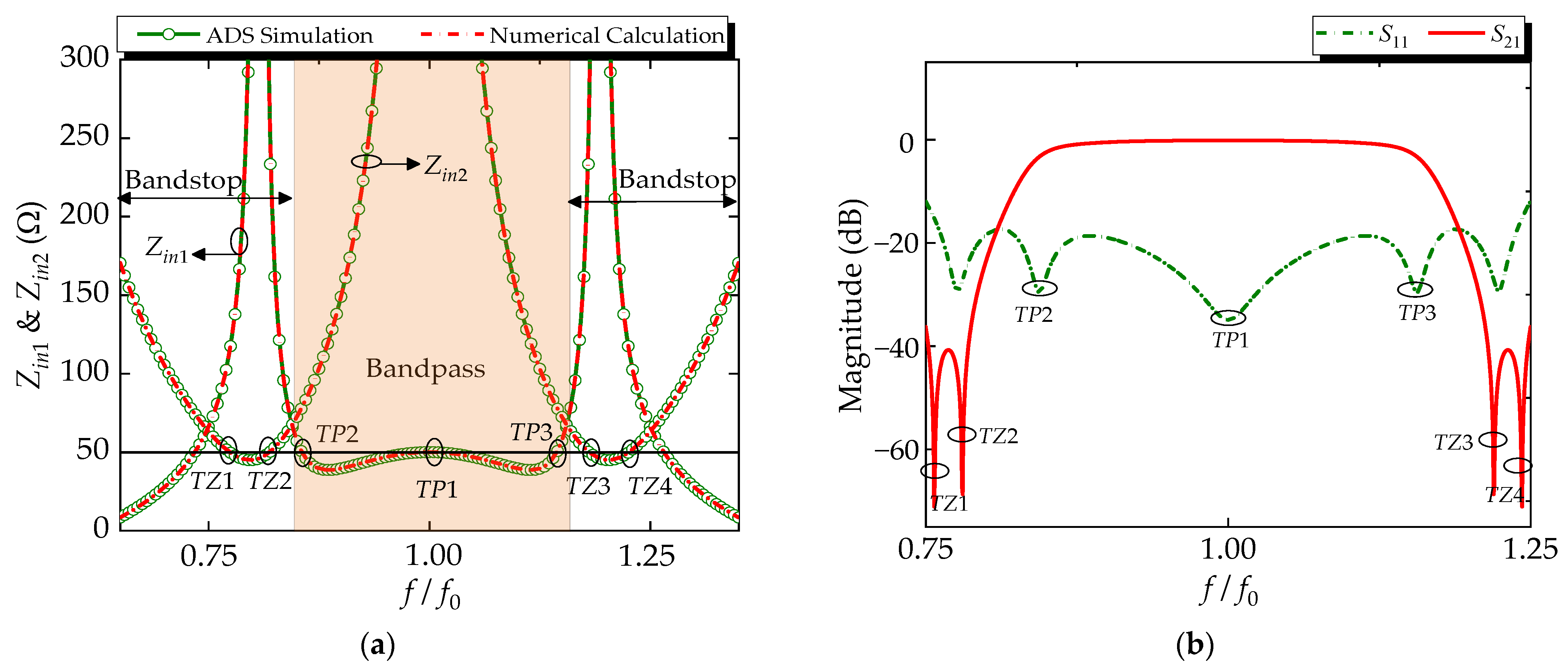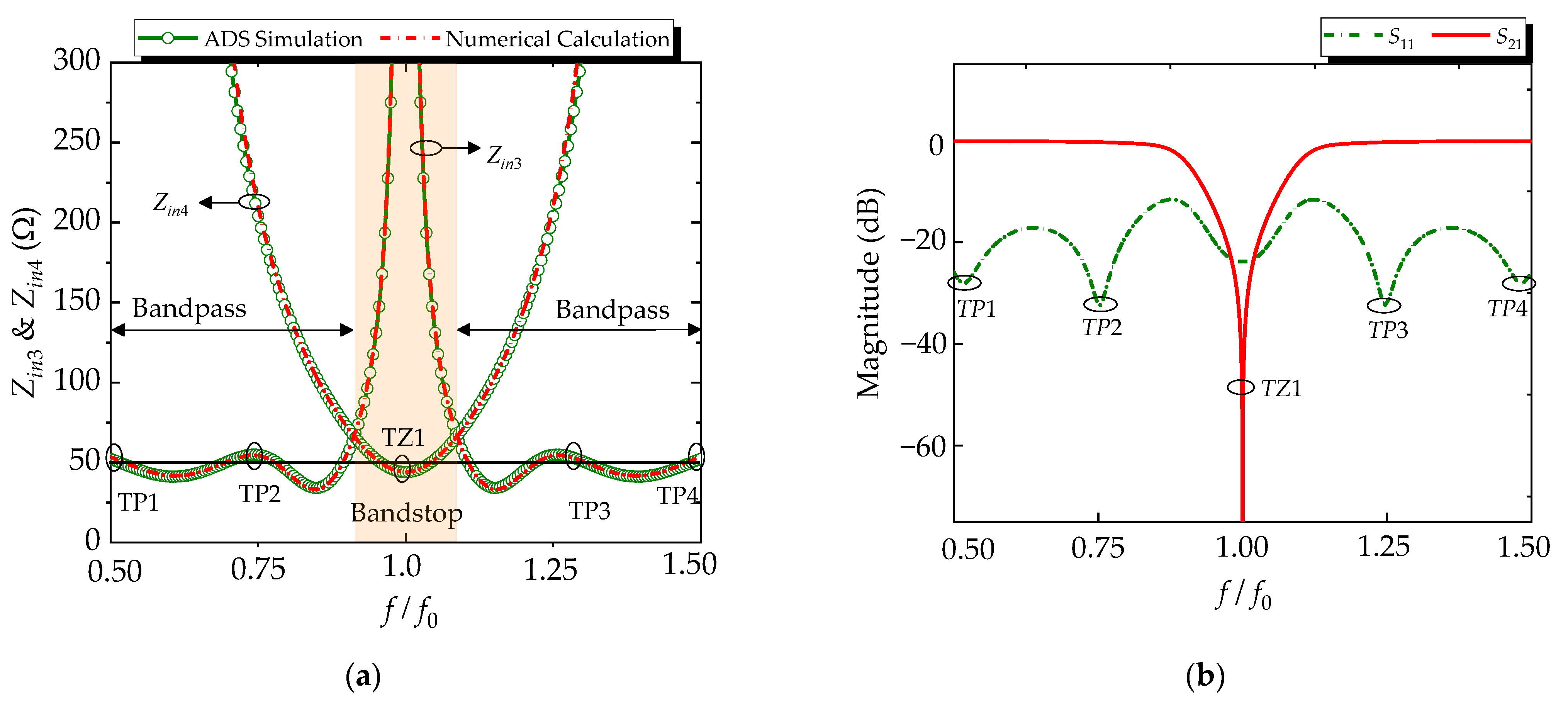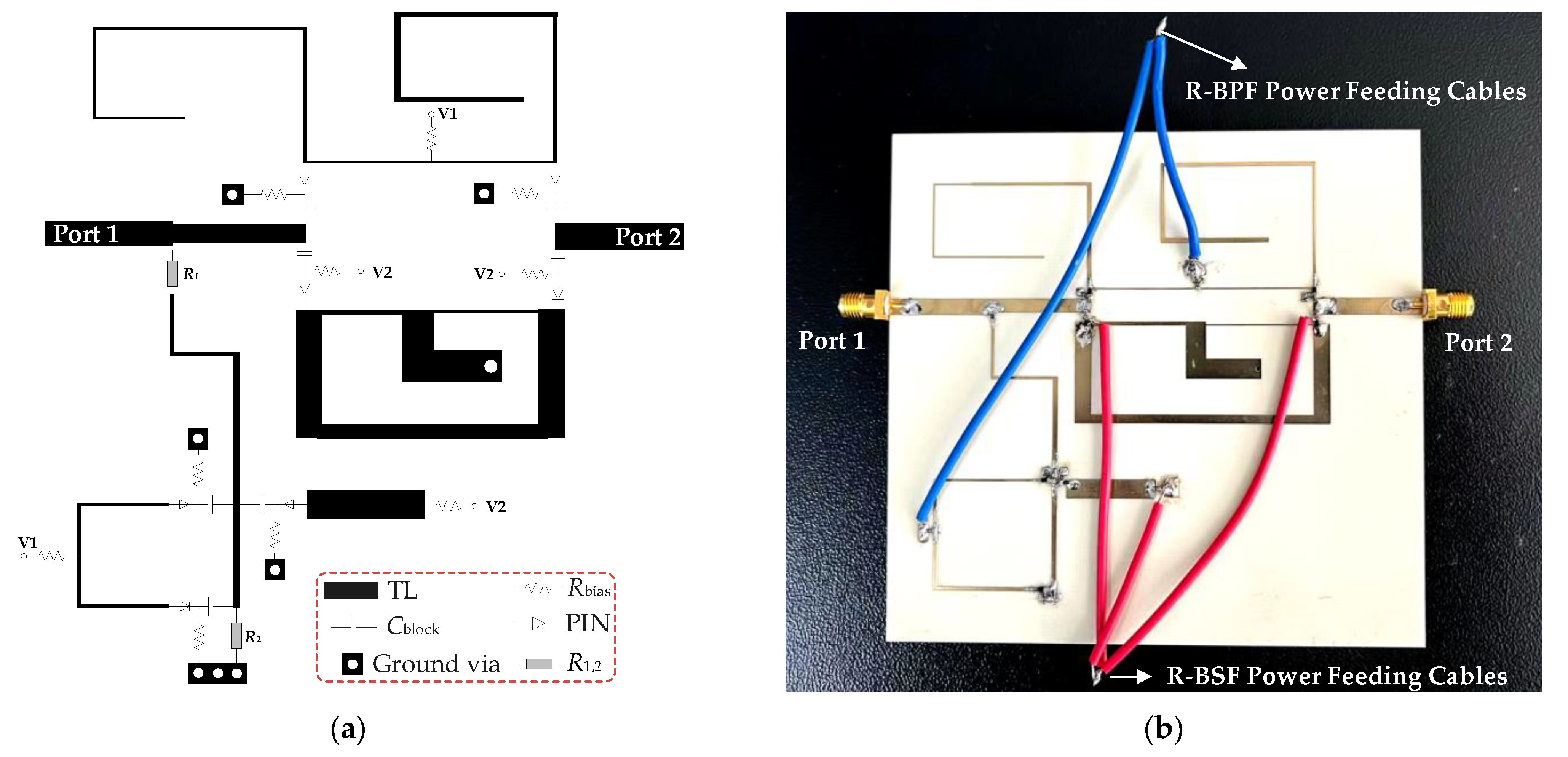Design of a Switchable Filter for Reflectionless-Bandpass-to-Reflectionless-Bandstop Responses
Abstract
:1. Introduction
2. Analysis of the Switchable R-BPF-to-R-BSF
2.1. R-BPF Mode
- (1)
- At f0 (θ = 90°), the value of Zin2 approaches 50 Ω, while Zin1 tends to be infinite. The signal energy is transmitted through the BPF, but the path to the absorption circuit section is interrupted.
- (2)
- At 0.75f0 and 1.25f0 (θ = 67.5° & 112.5°), the value of Zin2 approaches infinite, while Zin1 tends to 50 Ω. That is to say, the signal cannot pass through the BPF and is reflected to the absorptive circuit, and then dissipated by the loading resistors.
- (3)
- Three transmission poles (TP1–TP3) can be obtained to achieve a considerable bandwidth. Four transmission zeros (TZ1–TZ4) in the lower and upper bands can be generated to achieve a good out-of-band suppression.
2.2. R-BSF Mode
- (1)
- At f0 (θ = 90°), the value of Zin4 approaches 50 Ω, while Zin3 tends to be infinite. The path to the BSF is interrupted, and the reflected signal is transmitted to the absorptive circuit.
- (2)
- At the lower and upper passbands, the value of Zin4 approaches infinite, while Zin3 tends towards 50 Ω. Thus, the signal can pass through the BSF, and the absorptive circuit does not work.
- (3)
- Four transmission poles (TP1–TP4) and one transmission zero can be obtained to achieve a good filtering characteristic. The positions of transmission poles are: fTP1 = 0.5f0, fTP2 = 0.75f0, fTP3 = 1.25f0, fTP1 = 1.5f0, and one transmission zero is: fTZ1 = f0.
3. Design Procedure
4. Measured Results and Discussion
5. Conclusions
Author Contributions
Funding
Data Availability Statement
Conflicts of Interest
References
- Miller, A.; Hong, J.-S. Wideband Bandpass Filter with Reconfigurable Bandwidth. IEEE Microw. Wirel. Compon. Lett. 2010, 20, 28–30. [Google Scholar] [CrossRef]
- Tsai, H.-J.; Huang, B.-C.; Chen, N.-W.; Jeng, S.-K. A Reconfigurable Bandpass Filter Based on a Varactor-Perturbed, T-Shaped Dual-Mode Resonator. IEEE Microw. Wirel. Compon. Lett. 2014, 24, 297–299. [Google Scholar] [CrossRef]
- McClung, S.N.; Saeedi, S.; Sigmarsson, H.H. Band-Reconfigurable Filter with Liquid Metal Actuation. IEEE Trans. Microw. Theory Tech. 2018, 66, 3073–3080. [Google Scholar] [CrossRef]
- Lee, J.; Naglich, E.-J.; Sigmarsson, H.-H.; Peroulis, D.; Chappell, W.-J. New Bandstop Filter Circuit Topology and Its Ap-plication to Design of a Bandstop-to-Bandpass Switchable Filter. IEEE Trans. Microw. Theory Tech. 2013, 61, 1114–1123. [Google Scholar] [CrossRef]
- Lee, T.-H.; Lee, B.; Nam, S.; Kim, Y.–S.; Lee, J. Frequency-Tunable Tri-Function Filter. IEEE Trans. Microw. Theory Tech. 2017, 65, 4584–4592. [Google Scholar] [CrossRef]
- Li, D.; Xu, K.-D. Multifunctional Switchable Filter Using Coupled-Line Structure. IEEE Microw. Wirel. Compon. Lett. 2021, 31, 457–460. [Google Scholar] [CrossRef]
- Feng, W.; Shang, Y.; Che, W.; Gomez-Garcia, R.; Xue, Q. Multifunctional Reconfigurable Filter Using Transversal Signal-Interaction Concepts. IEEE Microw. Wirel. Compon. Lett. 2017, 27, 980–982. [Google Scholar] [CrossRef]
- Xu, J. A Microstrip Switchable Filter with Four Operating Modes. IEEE Microw. Wirel. Compon. Lett. 2016, 26, 101–103. [Google Scholar] [CrossRef]
- Song, K.; Chen, W.; Patience, S.R.; Chen, Y.; Iman, A.M.; Fan, Y. Compact Wide-Frequency Tunable Filter with Switchable Bandpass and Bandstop Frequency Response. IEEE Access 2019, 7, 47503–47508. [Google Scholar] [CrossRef]
- Zahari, M.-K.; Ahmad, B.-H.; Wong, P.-W.; Shairi, N.-A. Switchable bandstop to bandpass filter using parallel-coupled reso-nator. In Proceedings of the 2017 IEEE Asia Pacific Microwave Conference (APMC), Kuala Lumpur, Malaysia, 13–16 November 2017; pp. 513–516. [Google Scholar]
- Kumar, N.; Singh, Y.-K. Switchable compact widestopband bandstop filter to wideband bandpass filter. In Proceedings of the 2015 Asia-Pacific Microwave Conference (APMC), Nanjing, China, 6–9 December 2015; pp. 1–3. [Google Scholar]
- Zahari, M.-K.; Shairi, N.-A.; Ahmad, B.-H.; Zakaria, Z.; Wong, P.-W. Miniaturized Switchable Bandpass to Matched Bandstop Filter Using Stepped-Impedance Resonator. In Proceedings of the 2018 IEEE International Workshop on Electromagnetics: Applications and Student Innovation Competition (iWEM), Nagoya, Japan, 29–31 August 2018; pp. 1–2. [Google Scholar]
- Lin, Y.-S.; Zhuang, J.-H.; Wu, Y.-C.; Cheng, T.-H. Design and Application of Novel Single- and Dual-Band Reconfigurable Microwave Components with Filter and Coupler Functions. IEEE Trans. Microw. Theory Tech. 2022, 70, 3163–3176. [Google Scholar] [CrossRef]
- Fan, M.; Song, K.; Zhu, Y.; Fan, Y. Compact Bandpass-to-Bandstop Reconfigurable Filter With Wide Tuning Range. IEEE Microw. Wirel. Compon. Lett. 2019, 29, 198–200. [Google Scholar] [CrossRef]
- Yang, T.; Rebeiz, G.-M. A 1.9–2.6 GHz filter with both bandpass-to-bandstop reconfigurable function and band-pass-and-bandstop cascading function. In Proceedings of the 2017 IEEE MTT-S International Microwave Symposium (IMS), Honololu, HI, USA, 4–9 June 2017; pp. 264–266. [Google Scholar]
- Simpson, D.-J.; GÓmez-García, R.; Psychogiou, D. Tunable Multiband Bandpass-to-Bandstop RF Filters. In Proceedings of the 2018 IEEE/MTT-S International Microwave Symposium-IMS, Philadelphia, PA, USA, 10–15 June 2018; pp. 1363–1366. [Google Scholar]
- Morgan, M.A. Think Outside the Band: Design and Miniaturization of Absorptive Filters. IEEE Microw. Mag. 2018, 19, 54–62. [Google Scholar] [CrossRef]
- García, R.-G.; Muñoz-Ferreras, J.-M.; Psychogiou, D. Symmetrical Quasi-Absorptive RF Bandpass Filters. IEEE Trans. Microw. Theory Tech. 2019, 67, 1472–1482. [Google Scholar] [CrossRef]
- Chaudhary, G.; Jeong, Y. Arbitrary Prescribed Flat Wideband Group Delay Absorptive Microstrip Bandpass Filters. IEEE Trans. Microw. Theory Tech. 2021, 69, 1404–1414. [Google Scholar] [CrossRef]
- García, R.-G.; Muñoz-Ferreras, J.-M.; Psychogiou, D. RF Reflectionless Filtering Power Dividers. IEEE Trans. Microw. Theory Tech. 2019, 66, 933–937. [Google Scholar]
- Shao, J.-Y.; Lin, Y.-S. Narrowband Coupled-Line Bandstop Filter with Absorptive Stopband. IEEE Trans. Microw. Theory Tech. 2015, 63, 3469–3478. [Google Scholar] [CrossRef]
- Kong, M.; Wu, Y.; Zhuang, Z.; Liu, Y.; Kishk, A.A. Compact Wideband Reflective/Absorptive Bandstop Filter With Multitransmission Zeros. IEEE Trans. Microw. Theory Tech. 2019, 67, 482–493. [Google Scholar] [CrossRef]
- Yang, L.; García, R.R.-G.; Muñoz-Ferreras, J.-M.; Zhang, R. Input-Reflectionless Low-Pass Filter on Multilayered Di-plexer-Based Topology. IEEE Microw. Wireless Compon. Lett. 2020, 30, 945–948. [Google Scholar] [CrossRef]
- Lee, T.-H.; Laurin, J.-J.; Wu, K. Reconfigurable Filter for Bandpass-to-Absorptive Bandstop Responses. IEEE Access 2020, 8, 6484–6495. [Google Scholar] [CrossRef]
- Guyette, A.C.; Naglich, E.J.; Shin, S. Switched Allpass-to-Bandstop Absorptive Filters With Constant Group Delay. IEEE Trans. Microw. Theory Tech. 2016, 64, 2590–2595. [Google Scholar] [CrossRef]
- Zahari, M.-K.; Ahmad, B.-H.; Wen, W.-P.; Shairi, N.-A. Switchable absorptive bandstop to bandpass filter using dual-mode ring resonator. In Proceedings of the 2016 IEEE Asia-Pacific Conference on Applied Electromagnetics (APACE), Langkawi, Malaysia, 11–13 December 2016; pp. 248–251. [Google Scholar]







| Switch Type | Insertion Loss (dB) | Isolation (dB) | Voltage (V) | Current (mA) | Switching Time (ns) | Frequency (GHz) | Power Handling (W) |
|---|---|---|---|---|---|---|---|
| PIN diodes | 0.3–1 | >25 | 5–10 | 3–20 | 1–100 | ~40 | ~200 |
| MEMS | 0.4–2 | >25 | 5–30 | ~0 | 1–20 | ~40 | ~10 |
| MESFETs | 0.05–2 | >40 | 20–80 | 0 | 1000–40,000 | ~100 | ~1 |
| Ref. | Response | Reflectionless Modes | f0 (GHz) | FBW (%) | Insertion Loss (dB) | 10-dB RBW (%) | Type of Switching |
|---|---|---|---|---|---|---|---|
| [6] | BPF/BSF/ DB-BPF | NO | 1.92/1.92/1.58&2.23 | 53.1/30.2/3.8& 2.7 | 0.9/0.8/2&2.2 | No | PIN |
| [7] | UWB-BPF/NB-BPF/BSF | NO | 2.4/2.92/3 | 95.7/25.3/3 | 0.94/0.8/0.7 | No | PIN |
| [8] | BPF/BSF/ DB-BSF/ASF | NO | 1.92/2/1.61&2.36/2 | 9.7/50.2/21.1&20/ND | 1.95/1.1/1.2&1.9/ND | No | PIN |
| [24] | BPF/R-BSF | One mode | 2.16/2.58 | 2.95/<2 | 6.7/1.1 | NO/30.1% | SPDT |
| [26] | BPF/R-BSF | One mode | 2.4/2.4 | 26/<4 | ND/ND | NO/75.5% | PIN |
| This work | R-BPF/R-BSF | All modes | 2.05/1.98 | 36.7/13 | 1.73/0.8 | 61.9%/100% | PIN |
Disclaimer/Publisher’s Note: The statements, opinions and data contained in all publications are solely those of the individual author(s) and contributor(s) and not of MDPI and/or the editor(s). MDPI and/or the editor(s) disclaim responsibility for any injury to people or property resulting from any ideas, methods, instructions or products referred to in the content. |
© 2023 by the authors. Licensee MDPI, Basel, Switzerland. This article is an open access article distributed under the terms and conditions of the Creative Commons Attribution (CC BY) license (https://creativecommons.org/licenses/by/4.0/).
Share and Cite
Wu, G.; Wu, H.; Qin, W.; Shi, J.; Zhang, W.; Lin, L.; Li, Q. Design of a Switchable Filter for Reflectionless-Bandpass-to-Reflectionless-Bandstop Responses. Micromachines 2023, 14, 424. https://doi.org/10.3390/mi14020424
Wu G, Wu H, Qin W, Shi J, Zhang W, Lin L, Li Q. Design of a Switchable Filter for Reflectionless-Bandpass-to-Reflectionless-Bandstop Responses. Micromachines. 2023; 14(2):424. https://doi.org/10.3390/mi14020424
Chicago/Turabian StyleWu, Gangxiong, Hao Wu, Wei Qin, Jin Shi, Wei Zhang, Longlong Lin, and Qian Li. 2023. "Design of a Switchable Filter for Reflectionless-Bandpass-to-Reflectionless-Bandstop Responses" Micromachines 14, no. 2: 424. https://doi.org/10.3390/mi14020424





